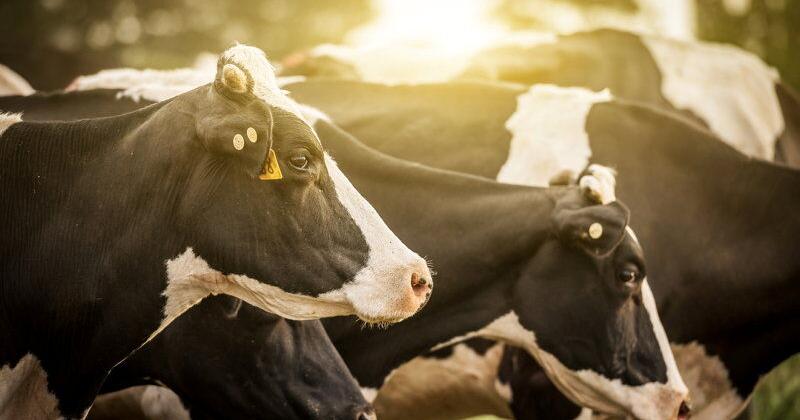
With feed prices projected to come down, Dairy Margin Coverage payouts may not come at the end of 2024. But global unknowns emphasize the constant need for risk management.
USDA’s World Agricultural Supply and Demand Estimates predict corn prices will fall to $4.80 per bushel after two years exceeding $6, said Chris Wolf, a Cornell professor of agricultural economics, during a Farm Credit East webinar on Jan. 24.
Soybeans are predicted at $12.75 per bushel, and soybean meal is at $3.80 a ton.
Based on the numbers, it’s likely U.S. farmers will be planting more soybeans, Wolf said.
“The rule of thumb has always been, and it’s been pretty useful over the years, that if soybean price is more than 2.4 times the price of corn, that means plant soybeans,” Wolf said. “If it’s less than 2.4 times the price of corn, then that means plant corn.”
USDA forecasts the all milk price at $20 per hundredweight, Class III at $16 and Class IV at $19 or $19.50. Futures are projecting higher Class III and Class IV prices, Wolf said.
Looking at the margin, Wolf is predicting Dairy Margin Coverage payouts around $1.50 for the beginning of the year, based on an all milk price estimate of $20.60.
In the second half of 2024, Wolf thinks there will be no margin payments.
In the long term, he’s concerned about the amount of cheese that is coming onto the market in the next two years or so. Consumption may not continue to rise fast enough to keep up, he said.
Another product that has consumption on the rise is lactose-free milk.
“Doing things with milk to meet the different markets to reflect the preferences of the population has certainly been happening,” Wolf said.
Fluid milk consumption is still on the decline, though.
Likewise, plant-based milk consumption has been decreasing since a 2021 peak. Almond milk is seeing a decline, while oat milk has increased and soy milk has stayed flat, Wolf said.
While farmers can’t change the market, there is room to reduce the cost of production, especially in Pennsylvania.
The state ranks eighth in the nation in milk production but has more cows than the sixth and seventh ranking states, Michigan and Minnesota, said Jayne Sebright, executive director of the Center for Dairy Excellence.
Nationally, milk production per cow is up 30%, while Pennsylvania is only up 15%, Sebright said in a Jan. 19 webinar. She identified the state’s slow technology adoption and aging infrastructure as disadvantages.
Improving cow efficiency could be important for creating stability despite unknowns. Economists have a grasp on the U.S. market, but there are a lot of factors waiting to fall globally.
For feed, Brazil and Argentina have more planted corn and soybeans than the U.S. But heavy rains and flooding are threatening Brazil’s crop, making it unclear how much will be sold into the U.S., Wolf said.
For U.S. exports, the county’s largest dairy purchaser is China. In the past, when China purchased large quantities at the beginning of the year, the milk prices for that year were high, Wolf said.
But China is facing economic turmoil with a housing bubble and distressed stock market, so Wolf said it is unclear how much or when China will contribute to U.S. sales.
Mexico may make up for lost export income. The buying power of the peso has been increasing compared to the dollar, so Mexico has been increasing purchases of U.S. dairy in recent years, Wolf said.
The European Union’s milk production and price are uncertain because on proposed environmental regulations, Wolf said. EU and New Zealand farmers have been protesting regulatory changes.
“They are some pretty darn restrictive rules if they actually get implemented the way they’ve been talking about it,” Wolf said.
The EU and U.S. have comparable milk prices while New Zealand’s are lower, Wolf said.
Risk Management
Risk management strategies can help with financial navigation of the unknown. Dairy Revenue Protection and Dairy Margin Coverage are the main program, though Dairy Margin Coverage for 2024 is not set up yet.
Wolf is confident it will be soon.
Dairy Revenue Protection insures the milk while Dairy Margin Coverage helps compensate for variation in the feed and milk price gap, said Rob Goodling, a Horizon Farm Credit ag business consultant, during the Center for Dairy Excellence webinar.
These are purchased by the quarter. For Dairy Revenue Protection, Marin Bozic, founder of Bozic LLC, found paying for a year at a time offers the best average return, even if it can be financially hard to justify with cost of production.
Coverage is also often necessary for more than one quarter when prices fall. On average, periods of financial struggle in the dairy sector last 12 to 15 months, Bozic said during the Farm Credit East webinar.
Going through a downturn uninsured could be devastating.
“You are not buying DRP for 3 cents this way or 9 cents that way,” Bozic said. “You’re buying DRP for situations when something really bad happens, prices drop three, four dollars.”
Many farmers are becoming hesitant to pay for coverage programs because the government keeps paying out after crises, Bozic said. He cautioned against this attitude, saying the timing of past crises may have influenced political stimulus.
“Not all crises fall in presidential election years,” Bozic said.
And while a pandemic may seem like a once-in-a-lifetime problem, difficult times aren’t.
“The point is that these one-offs keep on coming,” Bozic said.
Financial stability goes deeper than being insured. Producers should strive to understand their cost of production and what they can and can’t control within it, Goodling said.
Three major factors in cost of production are labor, feed, and interest and principal costs, Goodling said. The latter of the three have been particularly high and created problems for many farms recently.
“If we have to borrow money, it comes at a cost,” Goodling said. “So how much can our production and our farm take so that we can try and give our cost of production a chance to get us a margin that is achievable?”
A simple exercise for farmers is to compare revenue and expenses.
Farm Financial Standards Council guidelines suggests that ratio be at or below 60%, Goodling said. But his goal for dairies is closer to the 70% to 80% range.
Having other farm enterprises in addition to the dairy may help drive it lower.
Whether it’s Dairy Revenue Protection or Dairy Margin Coverage or another method, Bozic encouraged dairy farmers to come up with a risk management plan and stick to it.
“If you keep experimenting all around, you will never get the destination that you seek,” he said.





